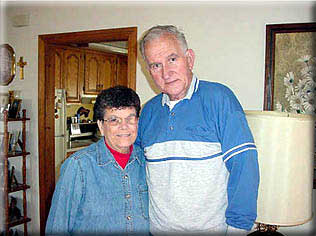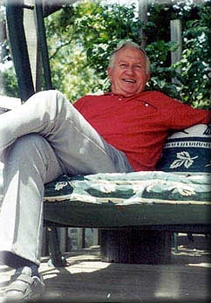Mr. Sherrick was in excellent health until January, 2000, when he grew short of breath. In April, he developed severe pain in his abdomen. St. John's of Tulsa admitted him emergently, but did not take any film, and he was discharged shortly after admission.
Chronicle Of A Compassionate Treater
Mr. Sherrick is not a complainer, and coped until September or October, when he went to a Eufaula cardiologist, Dr. Petrasko, because of acute shortness of breath. Dr. Petrasko performed a heart catheterization and took chest films. His condition continued to deteriorate. He was referred to a Muskogee pulmonologist, Dr. Lee.
Mr. Sherrick saw Dr. Lee one or two weeks before Thanksgiving. Dr. Lee performed a right-sided thoracentesis, withdrawing two pints of very bloody fluid. Dr. Lee wished to have him admitted for further diagnostic work-up, but Mr. Sherrick waited until November 25, the Saturday after Thanksgiving, at which time he was admitted to Muskogee Regional Medical Hospital. Another three quarts of fluid were drained through a chest tube during his stay there, which stretched until December 18.
On December 11, thoracic surgeon Dr. Rutlinger performed a right-sided thoracoscopy with biopsy and talc insufflation. Dr. Rutlinger emerged from the operating room and said that it was definitely cancer, a kind of cancer known as mesothelioma. Pathology later confirmed the diagnosis.
Mr. Sherrick was referred to a Muskogee oncologist, Dr. Vasireddy. The Tumor Board recommended that he seek treatment in New York City or Houston, as Tulsa did not have the requisite expertise to treat the cancer. He chose to seek treatment at M.D. Anderson because of its proximity. Mr. Sherrick and his wife left for Houston January 8, and met with thoracic surgeon Dr. W. Roy Smythe the next day. The Sherricks were very impressed with Dr. Smythe's knowledge, compassion, and the care he took in communicating the whys and wherefores of Mr. Sherrick' treatment options. The following e-mails from Dr. Smythe are published with his and the Sherricks' permission.
On January 27, 2001, Dr. Smythe e-mailed Carol Martin, one of the Sherricks' children:
Dear Carol,
Thank you for your correspondence. I am familiar with the ALIMTA drug. It has shown some activity in mesothelioma, as well as a number of other tumors. A great number of other drugs have also shown partial activity, as has ALIMTA in this tumor. Unfortunately, absolutely no chemotherapeutic agent has ever totally cured a patient with this tumor, and the response to Alimta has been partial. If you wish to pursue chemotherapy, I would strongly suggest that you consider one of the following options (if the pathology results from the lymph node biopsy are negative, and the MRI favorable):
(1) have the tumor removed surgically as we had discussed, followed by inclusion in the Alimta trial if they will allow postoperative patients. (2) have the tumor removed and speak with one of our oncologists about our experimental drugs (we have a large number of new drugs on study now here at Anderson, as many as any center in the worlk, some similar to Alimta) - we allow postoperative patients in most of these trials. We may also have the new form of postoperative radiation therapy we spoke of to use in addition to or instead of chemotherapy. (3) you may forego surgery and enter the Alimta trial, but I assure you that the chance of Mr. Sherrick being alive in 5 years would be much lower than with surgery with or without chemotherapy, although certainly with less short-term risk.
The only trial that has ever reported a good 5 year survival included surgery in the treatment of these patients. If the biopsy results are positive, the operation may be less effective, and we would need to discuss the options at this point, carefully weighing risks and benefits.
I am a mesothelioma researcher, and have a basic science laboratory here at Anderson dedicated to the treatment of this disease, I will try and be as objective as possible with any questions you may have. Please feel free to contact me at your convenience.
I hope that this is helpful, thanks again. - Dr. Smythe*
Dr. Smythe ordered a series of tests, including biopsies of Mr. Sherrick's lymph nodes, in order to determine whether he could perform an extra-pleural pneumonectomy (EPP), to be followed with chemotherapy and/or radiation therapy. On January 30, 2001, Mr. Sherrick learned that his tumor had invaded the lymph nodes, and that surgery was not an option. The Sherricks were disappointed and at the same time relieved that they would not have to make a decision regarding whether to undergo the rigors of tri-modal therapy.
On February 2, Dr. Smythe e-mailed Carol again, regarding the next step:
Dear Carol,
Thanks for your note. It has been a pleasure, I assure you, to care for your father. There are a number of staging systems for this tumor, and many of them don't agree with one another. I would say that he is stage III of a possible IV, and this means that he is in a "medium" stage range. His quality of life will depend greatly on whether or not he responds to chemotherapy (tumor shrinks) or if his tumor stablizes (growth stops for a time). As I had mentioned earlier, unfortunately, cure with chemotherapy alone is virtually unheard of.

What the family and your father should focus on now is to try to be optimistic regarding the therapy, and if that therapy is not incredibly successful, to have as a goal that he enjoy as much quality of life as possible in the time that he will have left. We will certainly hope for improvement, but again, if this is not possible, we have an entire department here at Anderson - The Department of Symptomatic and Palliative Care, that will help with pain, comfort and home care issues.
Dr. Kies is a very good clinical oncologist, and I know that you will like him. He can elaborate, as time goes by on the answers to many of your questions, some of which are not answerable at present. Although it may sound trite, you really have to take a "one day at a time" attitude at this point. I will keep you in my thoughts and prayers, and will always be accesible if you have a question or concern.
Take care,
Dr. Smythe
On February 6, 2001, Mr. Sherrick met with Dr. Kies, an oncologist at M.D. Anderson. Dr. Kies felt that Mr. Sherrick's condition was too weakened to withstand chemotherapy, including that offered in clinical trials. The Sherricks are following Dr. Smythe's advice to take it "one day at a time."
Mr. Sherrick stands six feet, four inches tall. He weighed approximately 238 pounds before falling ill. He currently weighs 180 pounds. He understands that the tumor extends around his right lung. He senses that the fluid is returning despite the talc pleurodesis. He currently takes 60 milligrams of MS Contin (a morphine-based drug) every eight to twelve hours for pain relief. Carol writes:
His health is continuing to weaken. He now only walks with a walker and only from his chair to the bedroom. We are no longer taking trips outside the house. This disease is a very mean type of cancer. It seems when this cancer makes a change it is a BIG change . . . it doesn't gradually move into a different physical state, it JUMPS. One day we can walk without assistance, the next day it's a total assist.
Before he fell ill, Mr. Sherrick played the harmonica in church and other gatherings. He can still make the harmonica sound like the plaintive wail of a passing train, but the few moments effort leaves him short of breath. A deeply religious couple, the Sherricks have placed their faith in God. Our thoughts and prayers are with this wonderful couple.
* The inclusion of Dr. Smythe's correspondence does not imply that the University of Texas, The University of Texas M.D. Anderson or any of its staff endorses this law firm or any other law firm. We wish to thank Dr. Smythe for allowing us to reprint his letter.
*** POSTED MARCH 5, 2001 ***
An Update -- March 23, 2001
from John's Daughter, Carol
1. Dad has lost down to 170 lbs.
2. Medications
a. 60 mg MS Contin every 8 hours
b. 1-2 tsp Morphine/Sulfate 10mg/5ml every 1-2 hours for break through pain
c. Megace for appetite
3. He is loosing control of his right foot/leg
4. He walks only with a walker from bed to his chair and back
5. He has NO appetite
6. His urine output is decreasing
7. He now sleeps in a hospital bed.
8. He is complaining of more intense pain and in different areas.
9. Constipation is always a problem.
10. He is beginning to have short term memory losses.
We think the cancer is probably into the endocron system now. Last week he had a spell of his body going into a self medicated state of natural chemicals that kept him out for about 36 hours. His body temp dropped to 94.2; his heart rate went up to 110+; his respiration dropped to 8 per minute. We really didn't think we would make it through the weekend, but he did.
He's very weak. It's hard to get him to eat. We have good days that we are thankful for and bad days that we endure.
Mr. Sherrick passed away on April 26, 2001

